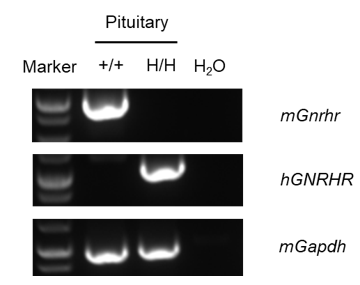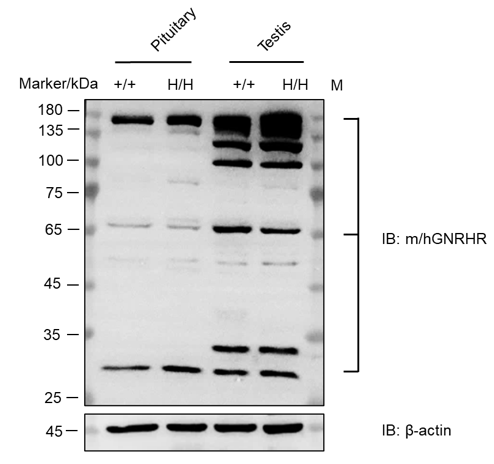B-hGNRHR mice
| Strain Name | C57BL/6JNifdc-Gnrhrtm2(GNRHR)Bcgen/Bcgen | Common Name | B-hGNRHR mice |
| Background | C57BL/6JNifdc | Catalog number | 112344 |
|
Related Genes |
GNRHR1, GRHR, HH7, LHRHR, LRHR | ||
|
NCBI Gene ID |
2798 | ||
- GNRHR: Receptor for gonadotropin releasing hormone (GnRH) that mediates the action of GnRH to stimulate the secretion of the gonadotropic hormones luteinizing hormone (LH) and follicle- stimulating hormone (FSH). This receptor mediates its action by association with G-proteins that activate a phosphatidylinositol- calcium second messenger system. Isoform 2 may act as an inhibitor of GnRH-R signaling. Defects in GNRHR are a cause of idiopathic hypogonadotropic hypogonadism (IHH). IHH is defined as a deficiency of the pituitary secretion of follicle-stimulating hormone and luteinizing hormone, which results in the impairment of pubertal maturation and of reproductive function. Defects in GNRHR are a cause of fertile eunuch syndrome (FEUNS). Fertile eunuch syndrome is a mild phenotypic form of HH going with the presence of normal testicular size and some degree of spermatogenesis. Belongs to the G-protein coupled receptor 1 family. 2 isoforms of the human protein are produced by alternative splicing.
- Protein type: GPCR, family 1; Membrane protein, integral; Membrane protein, multi-pass; Receptor, GPCR. Chromosomal Location of Human Ortholog: 4q21.2. Cellular Component: membrane; integral to plasma membrane; plasma membrane.
- Molecular Function: gonadotropin-releasing hormone receptor activity; peptide binding. Biological Process: G-protein coupled receptor protein signaling pathway; multicellular organismal development. Disease: Hypogonadotropic Hypogonadism 7 With Or Without Anosmia.
mRNA expression analysis

Strain specific analysis of GNRHR mRNA expression in wild-type C57BL/6JNifdc mice and B-hGNRHR mice by RT-PCR. Pituitary RNA were isolated from wild-type C57BL/6JNifdc mice (+/+) and homozygous B-hGNRHR mice (H/H), then cDNA libraries were synthesized by reverse transcription, followed by PCR with mouse or human GNRHR primers. Mouse Gnrhr mRNA was detectable in wild-type. Human GNRHR mRNA was detectable only in homozygous B-hGNRHR mice but not in wild-type mice.

Western blot analysis of GNRHR protein expression in homozygous B-hGNRHR mice. Pituitary and testis tissue lysates were collected from wild-type C57BL/6JNifdc mice (+/+) and homozygous B-hGNRHR mice (H/H), and then analyzed by western blot with anti-GNRHR antibody (Abcam, ab183079). 40 μg total proteins were loaded for western blotting analysis. GNRHR was detected in pituitary and testis in wild-type mice and homozygous B-hGNRHR mice, as the antibody is cross-recognize both human and mouse GNRHR. (The GnRHR include a 30 kDa GnRHR I variant, a mature 64 kDa variant, a 136 kDa variant.)









